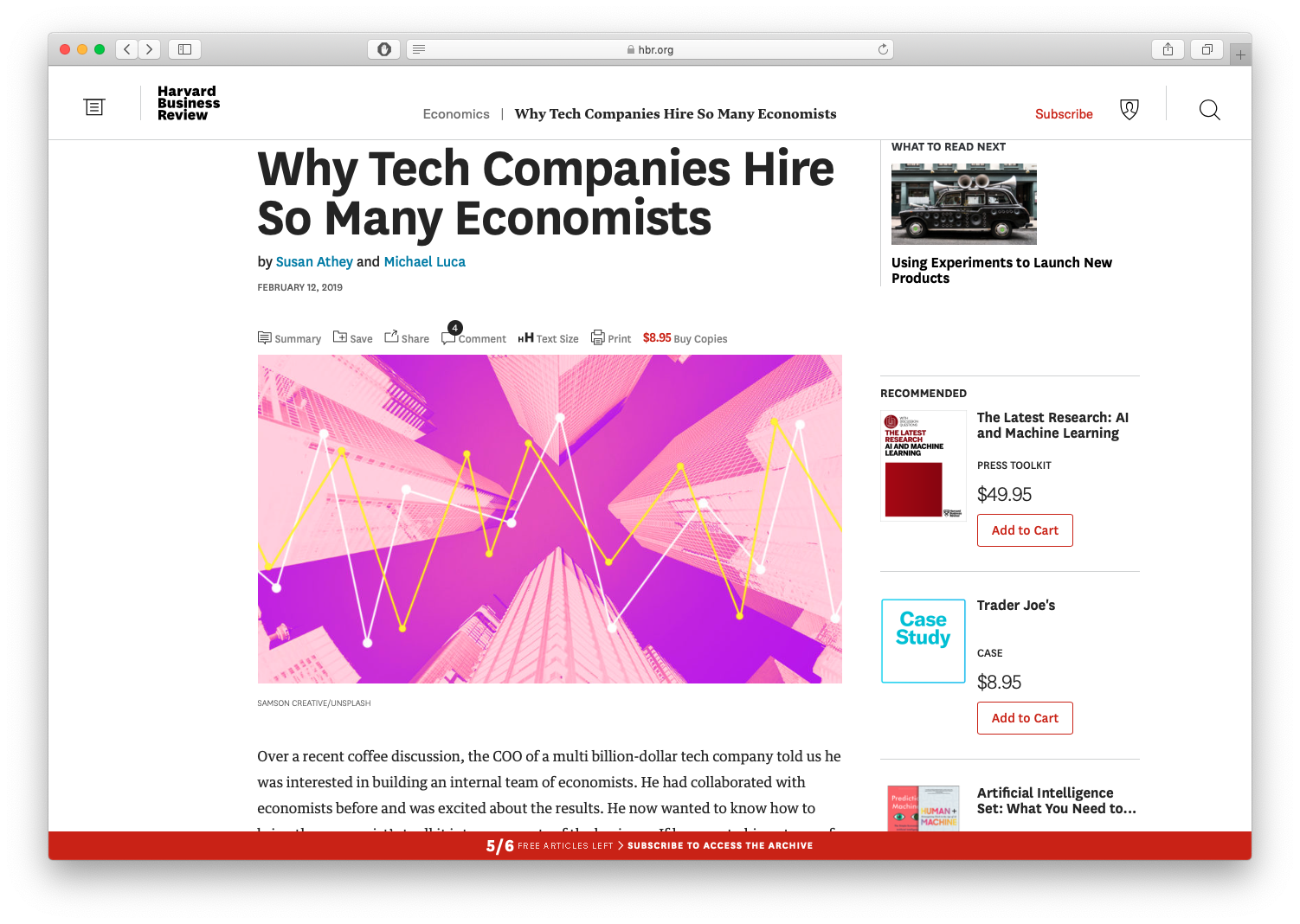1.2 — Budget Constraint
ECON 306 • Microeconomic Analysis • Spring 2021
Ryan Safner
Assistant Professor of Economics
safner@hood.edu
ryansafner/microS21
microS21.classes.ryansafner.com
The Two Major Models of Economics as a "Science"
Optimization
Agents have objectives they value
Agents face constraints
Make tradeoffs to maximize objectives within constraints
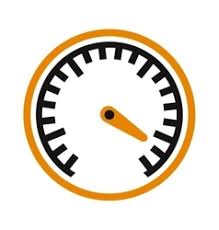
Equilibrium
Agents compete with others over scarce resources
Agents adjust behaviors based on prices
Stable outcomes when adjustments stop

Rational Choice Theory
The Logic of Choice: Ends and Means
Each of us acts purposefully
We have ends, goals, desires, objectives, etc
We use means in the world that we believe will achieve our ends

The Logic of Choice: Purpose
Acting with purpose distinguishes humans from everything else in the universe
Artificial intelligence researchers face "the frame problem"
- We thought: computation is hard, perception is easy
- We've found: computation is easy, perception is hard!

Causal Inference I
Machine learning and artificial intelligence are "dumb"
With the right models and research designs, we can say "X causes Y" and quantify it!
Economists are in a unique position to make causal claims that mere statistics cannot

For more, see my blog post, and Pearl & MacKenzie (2018), The Book of Why
Causal Inference II
"First, the field of economics has spent decades developing a toolkit aimed at investigating empirical relationships, focusing on techniques to help understand which correlations speak to a causal relationship and which do not. This comes up all the time — does Uber Express Pool grow the full Uber user base, or simply draw in users from other Uber products? Should eBay advertise on Google, or does this simply syphon off people who would have come through organic search anyway? Are African-American Airbnb users rejected on the basis of their race? These are just a few of the countless questions that tech companies are grappling with, investing heavily in understanding the extent of a causal relationship."
Goods and Services
Actions that satisfy human desires provide a service
An object that can provide services is called an economic good or a resource
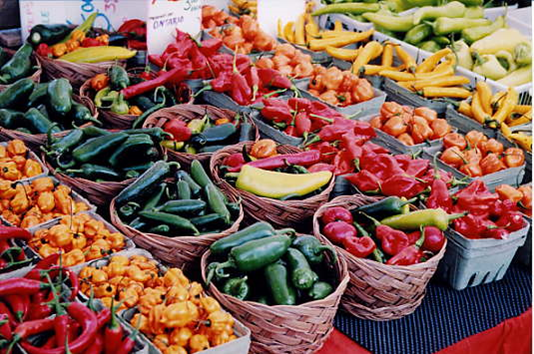

Consumption
- Goods and services provide "utility" (satisfaction of a desire) when we consume them

Bads
- An economic bad is something that hinders our ability to satisfy our desires

The Law of Demand
Perhaps the most fundamental economic “law” is the law of demand:
- inverse relationship between price and quantity consumed
- i.e. demand curves slope downwards
We investigate its source, and derive more useful properties
First, we will need to develop a more rigorous framework
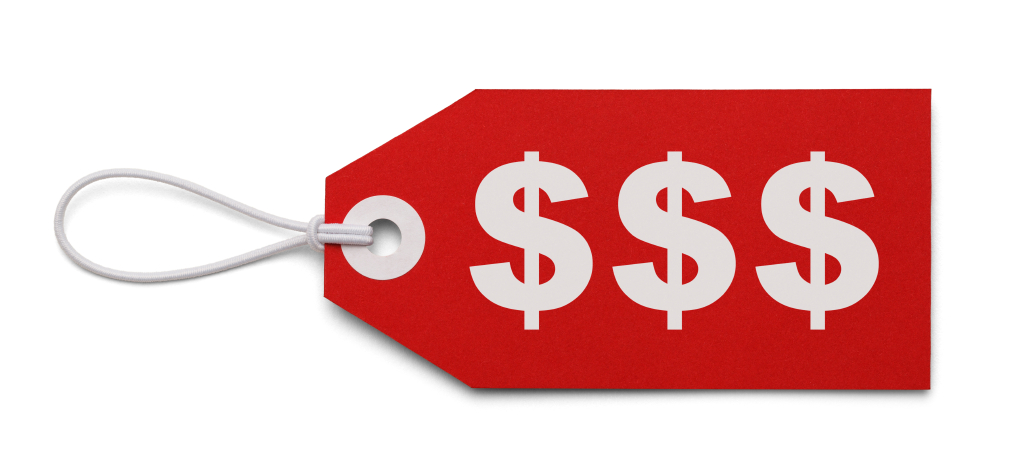
Rational Choice Theory
How do people decide:
- which products to buy
- which activities to dedicate their time to
- how to save or invest/plan for the future
Rational choice theory: assume that they optimize within constraints
A model of behavior we can extend to most scenarios
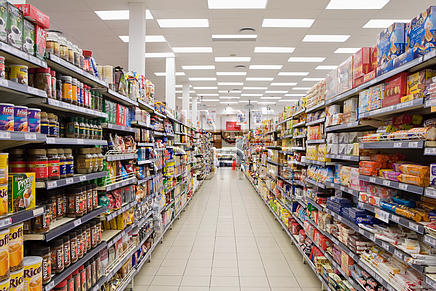
Rational Choice Theory: Beyond Consumers
Often called “Consumer Theory” in textbooks, but realize:
Everyone is “a consumer”
- "Goods and services" aren't just food, clothing, etc, but anything that you value! (free time, friendship, reputation, etc.)
- Producers demand productive inputs
We are really modeling how individuals make choices in almost any context!

Consumption Bundles
Imagine a (very strange) supermarket sells xylophones (x) and yams (y)
Your choices: amounts of {x,y} to consume as a bundle

Consumption Bundles: Graphically
We can represent bundles graphically
We'll stick with 2 goods (x,y) in 2-dimensions†
Example:
- x: 2 units
- y: 3 units

† See appendix in today's class page to extend to n goods!
The Budget Constraint
Affordability
If you had $100 to spend, what bundles of goods {x,y} would you buy?
Only those bundles that are affordable
Denote prices of each good as {px,py}
Let m be the amount of income a person has

Affordability
If you had $100 to spend, what bundles of goods {x,y} would you buy?
Only those bundles that are affordable
Denote prices of each good as {px,py}
Let m be the amount of income a person has
A bundle {x,y} is affordable at given prices {px,py} when:
pxx+pyy≤m

The Budget Set
- The set of all affordable bundles that a consumer can choose is called the budget set or choice set
pxx+pyy≤m

The Budget Set & the Budget Constraint
- The set of all affordable bundles that a consumer can choose is called the budget set or choice set
pxx+pyy≤m
- The budget constraint is the set of all bundles that spend all income m:†
pxx+pyy=m

† Note the difference (the in/equality): budget constraint is the subset of the budget set that spends all income.
The Budget Constraint, Graphically
- For 2 goods, (x,y)
pxx+pyy=m
The Budget Constraint, Graphically
- For 2 goods, (x,y)
pxx+pyy=m
- Solve for y to graph
y=mpy−pxpyx

The Budget Constraint, Graphically
- For 2 goods, (x,y)
pxx+pyy=m
- Solve for y to graph
y=mpy−pxpyx
- y-intercept: mpy
- x-intercept: mpx

The Budget Constraint, Graphically
- For 2 goods, (x,y)
pxx+pyy=m
- Solve for y to graph
y=mpy−pxpyx
- y-intercept: mpy
- x-intercept: mpx
- slope: −pxpy

The Budget Constraint, Graphically
- For 2 goods, (x,y)
pxx+pyy=m
- Solve for y to graph
y=mpy−pxpyx
- y-intercept: mpy
- x-intercept: mpx
- slope: −pxpy
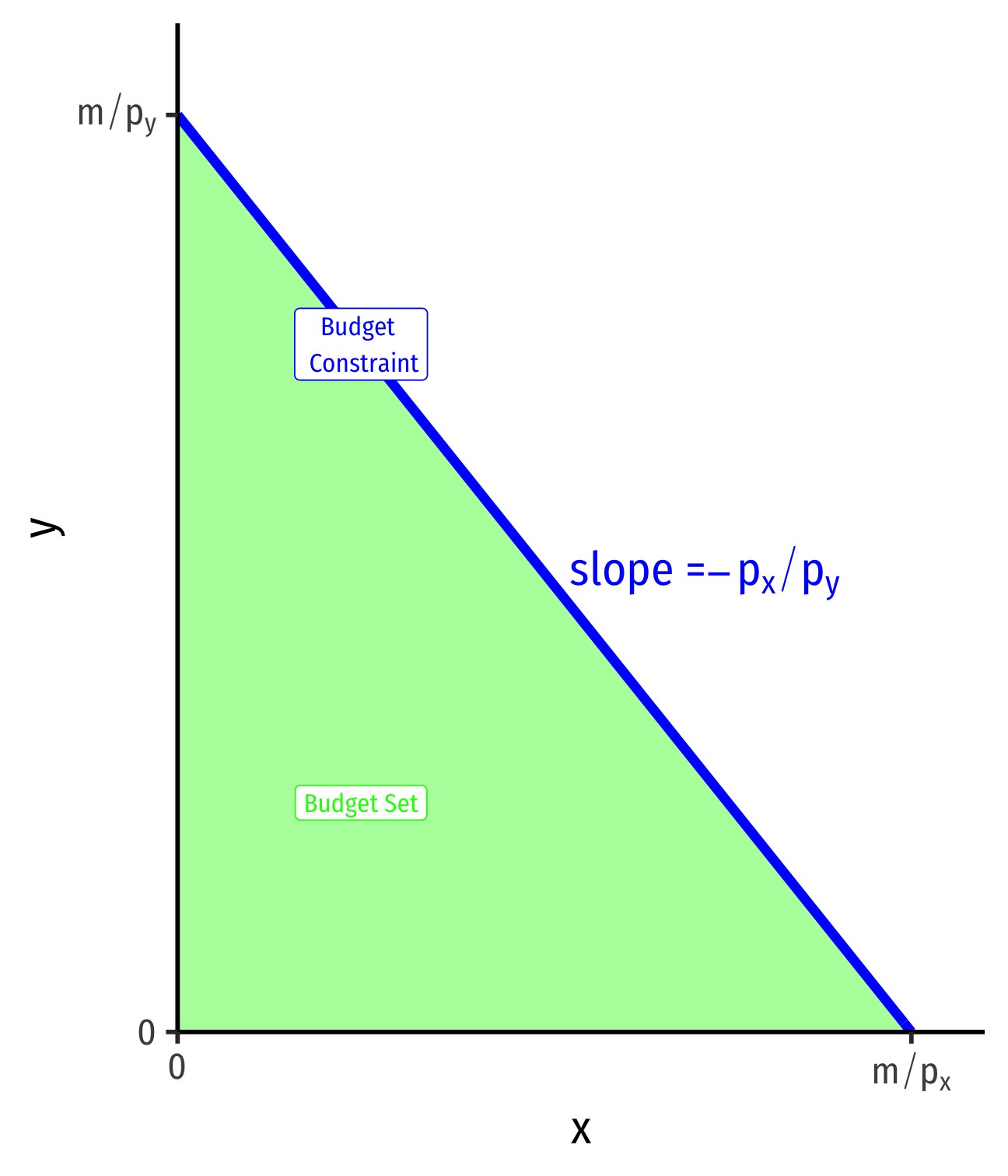
The Budget Constraint: Example
Example: Suppose you have an income of $50 to spend on lattes (l) and burritos (b). The price of lattes is $5 and the price of burritos is $10.
Let l be on the horizontal axis and b be on the vertical axis.
Write an equation for the budget constraint (in graphable form).
Graph the budget constraint.
Interpreting the Budget Constraint
- Points on the line spend all income
- A: $5(0x)+$10(5y)=$50
- B: $5(10x)+$10(0y)=$50
- C: $5(2x)+$10(4y)=$50
- D: $5(6x)+$10(2y)=$50
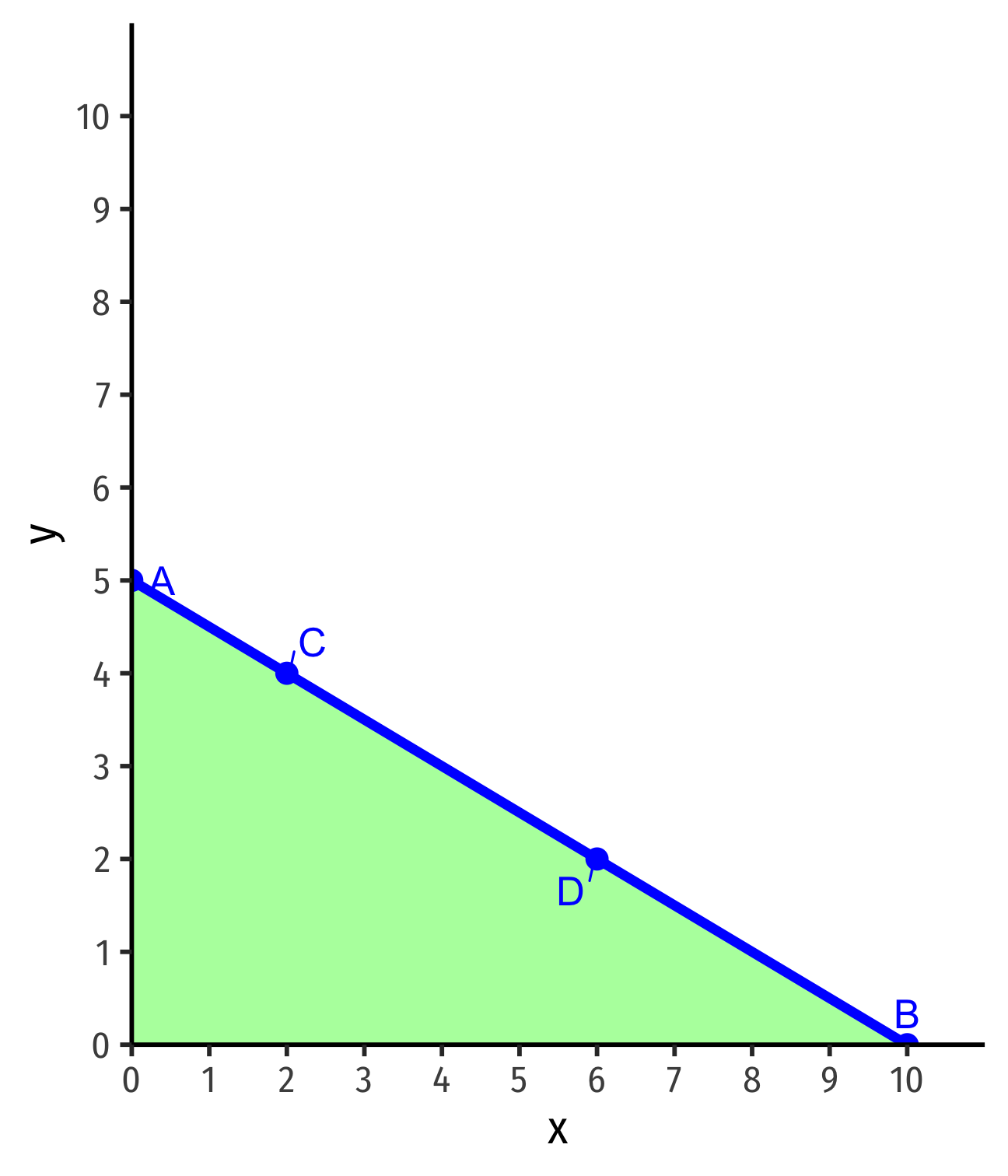
Interpreting the Budget Constraint
Points on the line spend all income
- A: $5(0x)+$10(5y)=$50
- B: $5(10x)+$10(0y)=$50
- C: $5(2x)+$10(4y)=$50
- D: $5(6x)+$10(2y)=$50
Points beneath the line are affordable but don't use all income
- E: $5(3x)+$10(2y)=$35
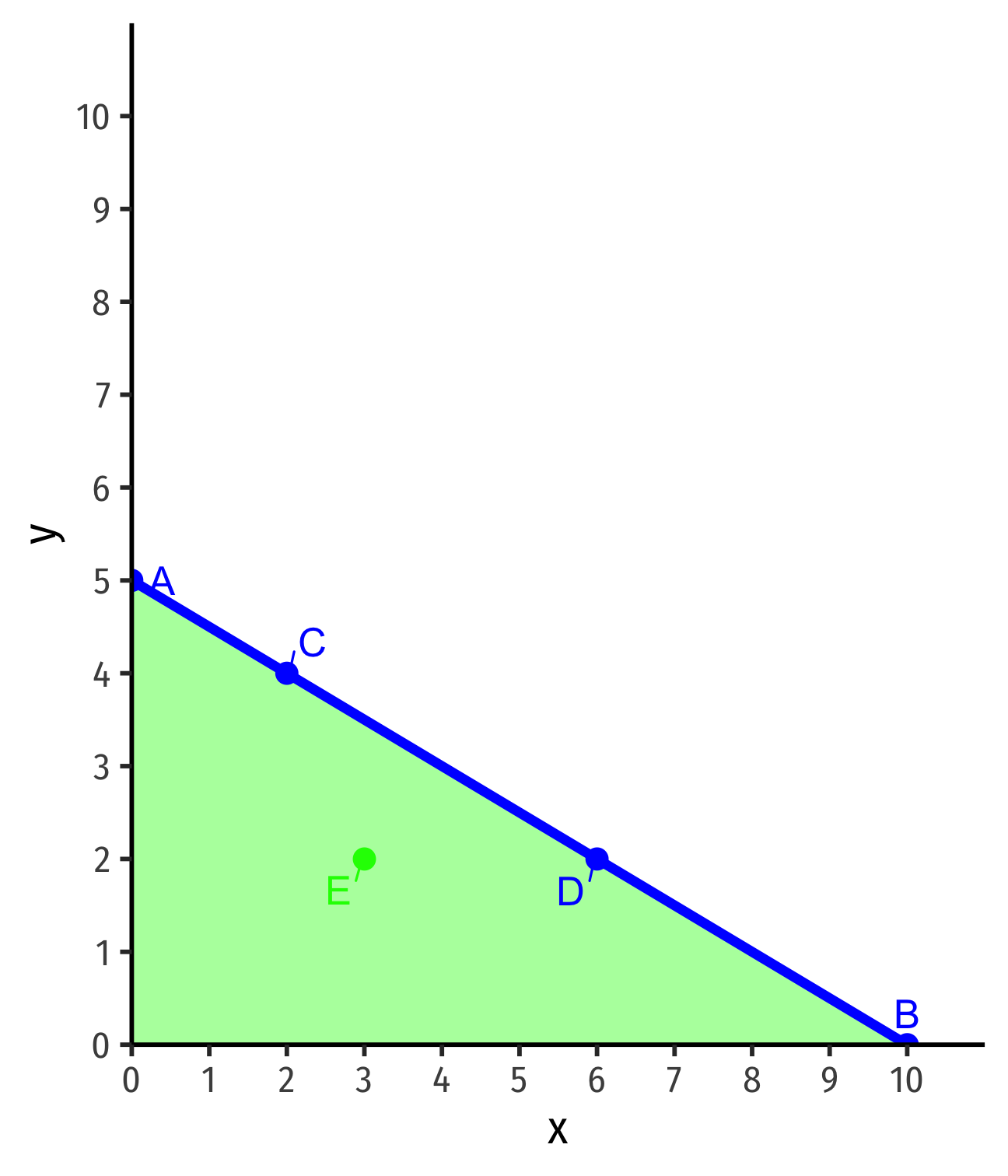
Interpreting the Budget Constraint
Points on the line spend all income
- A: $5(0x)+$10(5y)=$50
- B: $5(10x)+$10(0y)=$50
- C: $5(2x)+$10(4y)=$50
- D: $5(6x)+$10(2y)=$50
Points beneath the line are affordable but don't use all income
- E: $5(3x)+$10(2y)=$35
Points above the line are unaffordable (at current income and prices)
- F: $5(6x)+$10(4y)=$70
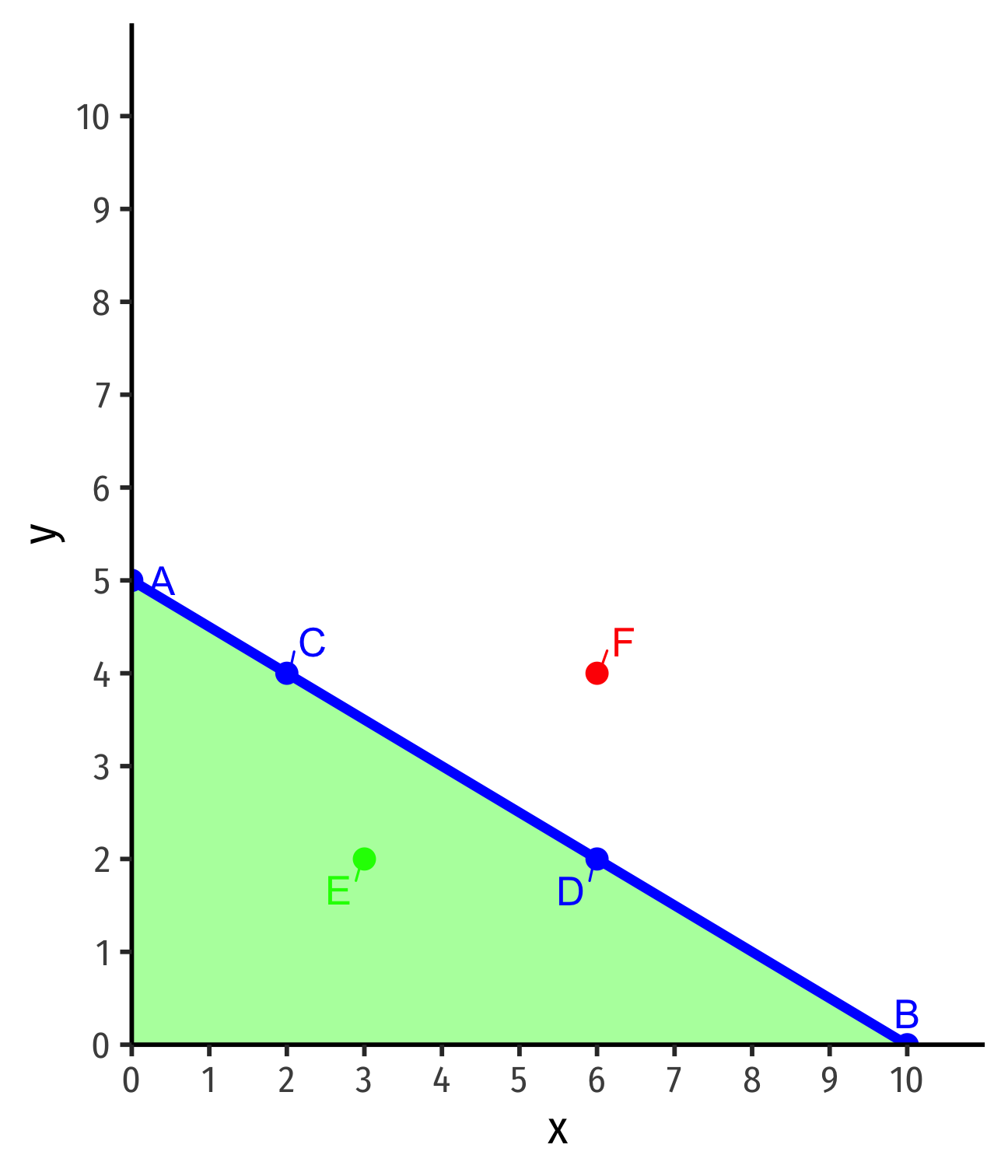
Opportunity Cost
Interpretting the Slope
Slope: tradeoff between x and y at market prices
- Market “exchange rate” between x and y
Relative price of x, or the opportunity cost of x:
Consuming 1 more unit of x requires giving up (pxpy) units of y
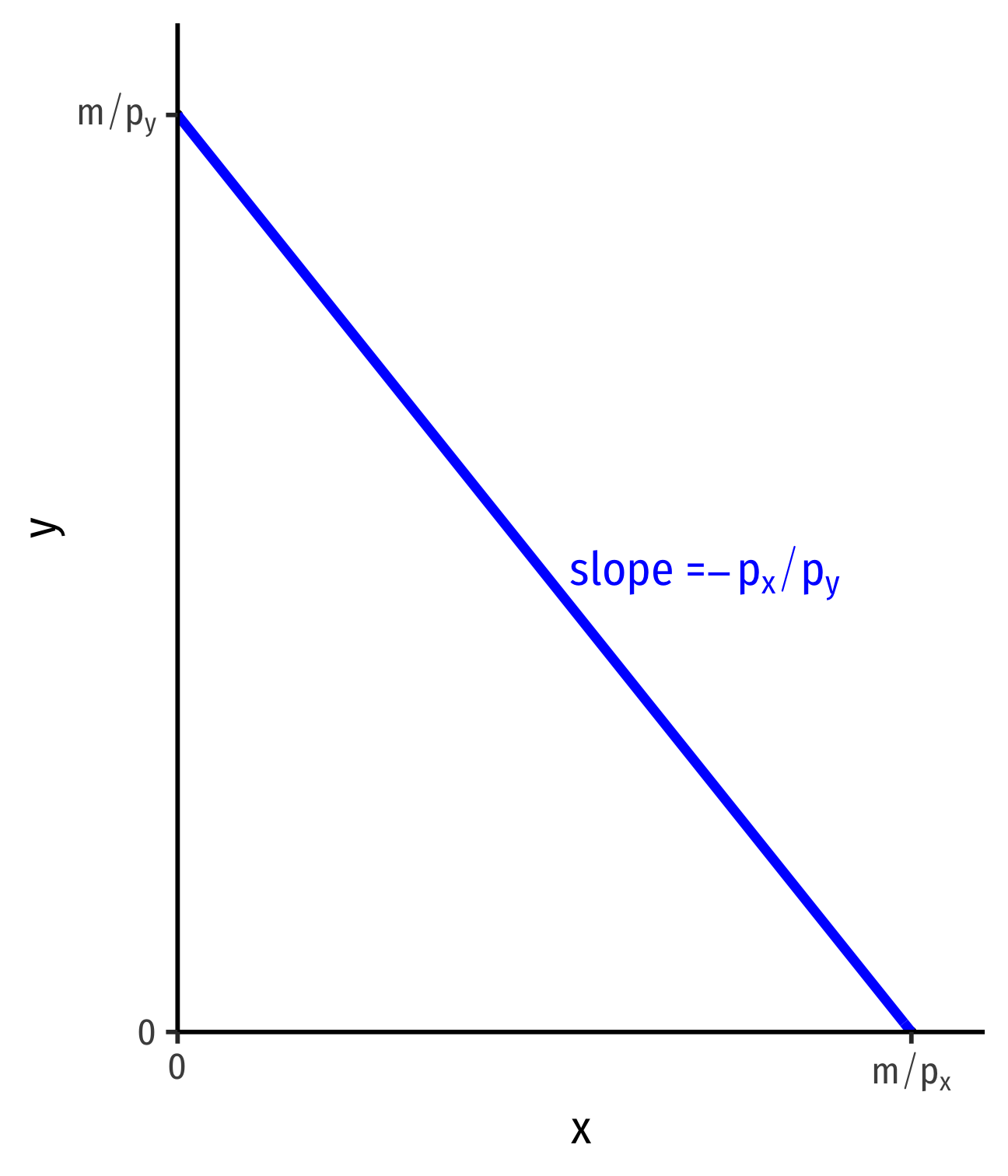
Opportunity Cost
Opportunity cost: value of next best foregone opportunity
Even though we have prices denoted in dollars, when you consume x, you're really giving up the opportunity to consume y!
- (in fact, we can do this without money, and it would be the same)

The Parable of the Broken Window
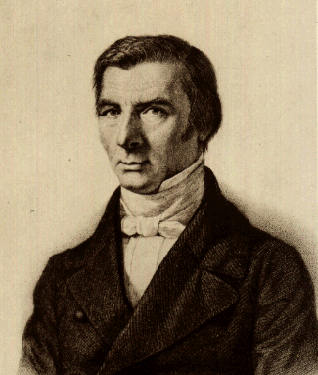
Frederic Bastiat
1801-1850
- That Which is Seen and That Which is Not Seen
The Parable of the Broken Window

Frederic Bastiat
1801-1850
That Which is Seen and That Which is Not Seen
"That which is seen"
- The broken window
- Resources diverted into glassmaking
The Parable of the Broken Window

Frederic Bastiat
1801-1850
That Which is Seen and That Which is Not Seen
"That which is seen"
- The broken window
- Resources diverted into glassmaking
"That which is not seen"
- Opportunity cost of fixing the window
- Resources diverted away from other opportunities
Applying the Parable of the Broken Window
- What does it mean to say that "spending money 'stimulates' the economy"?
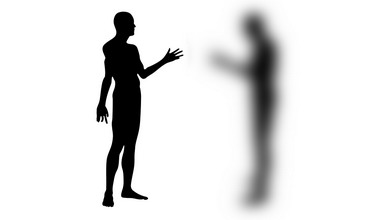
Applying the Parable of the Broken Window
What does it mean to say that "spending money 'stimulates' the economy"?
Scarce resources used in one industry can not be used in other industries
Every (visible) decision to spend on X yields more X, and destroys an (invisible) opportunity to spend on Y

Changes in Market Conditions
Changes in Market Conditions
m=pxx+pyyy=mpy−pxpyx
Budget constraint is a function of specific parameters
- m: income
- px,py: market prices
Economic analysis: how changes in constraints affect people's choices
- “incentives”

Changes in Income, m
- Changes in income ⟹ a parallel shift
Example: Income increases m1→m2
Slope unchanged (no change in prices!)
Gain of affordable bundles
- Exact opposite shift for a decrease in income
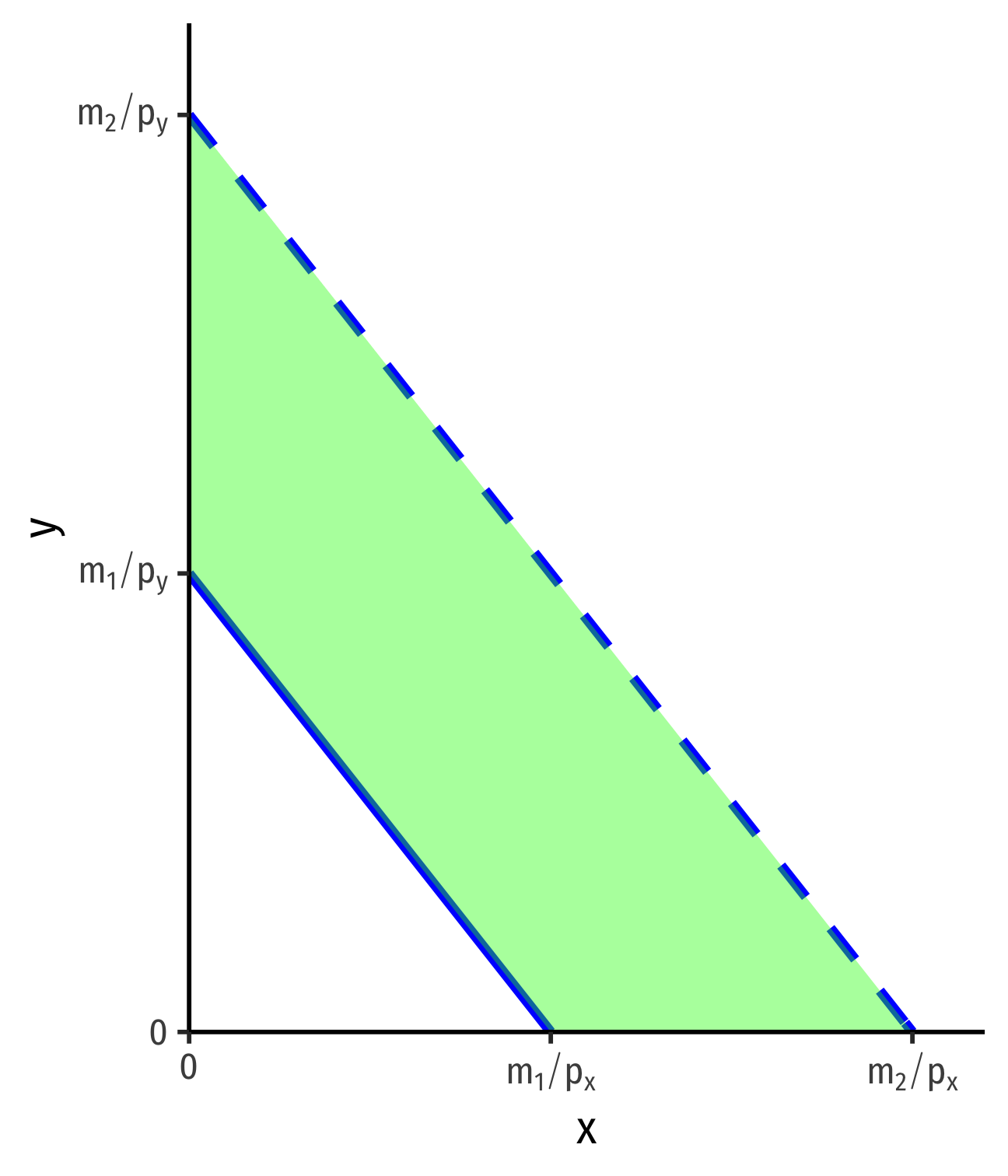
Changes in Income, m: Example
Example: Continuing the lattes and burritos example, (income is $50, lattes are $5, burritos are $10), suppose your income doubles to $100.
Find the equation of the new budget constraint (in graphable form).
Graph the new budget constraint.
Changes in Relative Prices, px or py
- Change in relative prices: rotate the budget constraint
Example: An increase in the price of x
Slope steepens: −p′xpy
Loss of affordable bundles
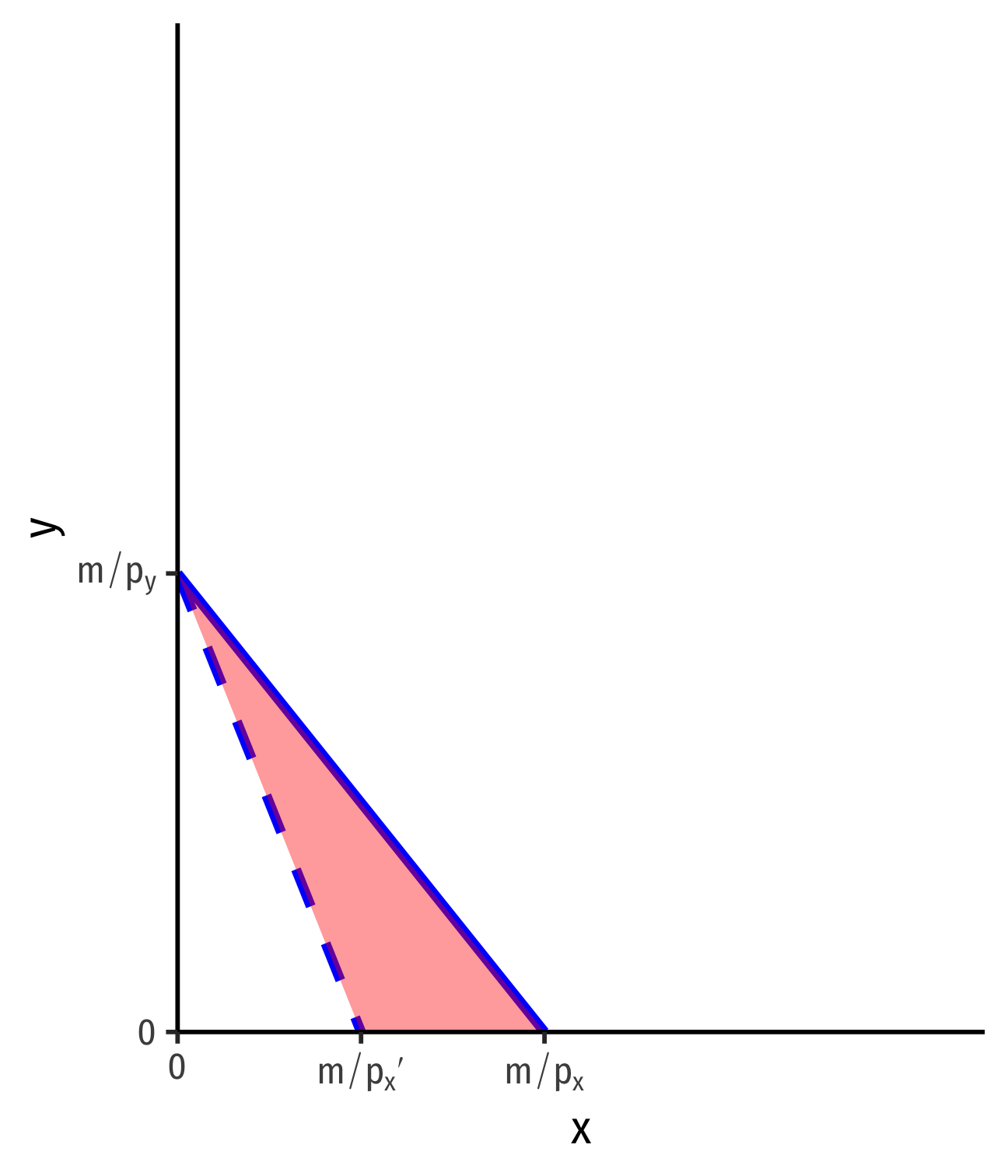
Changes in Relative Prices, px or py
- Changes in relative prices: rotate the budget constraint
Example: A decrease in the price of y
Slope steepens: −pxp′y
Gain of affordable bundles
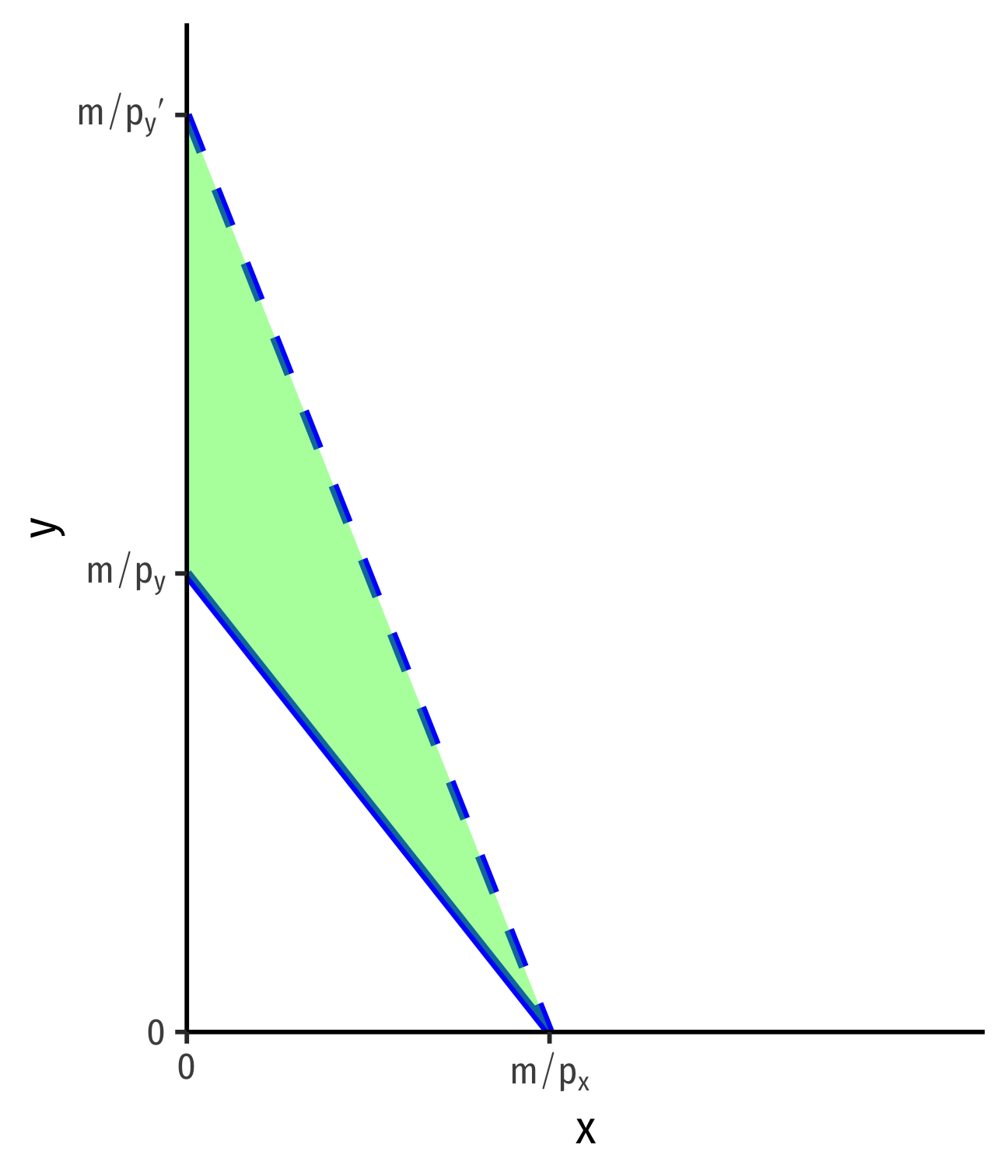
Economics is About (Changes in) Relative Prices
Economic analysis is about (changes in) relative prices
Budget constraint slope (opportunity cost of x) is −(pxpy)
Only "real" changes in relative prices (from changes in market conditions) change consumer constraints (and alter behavior)
i.e. not “the price of x,” its about “the price of x relative to the price of y”!

Economics is About (Changes in) Relative Prices
- “Nominal” prices are often meaningless!
- Need to make comparisons between prices of different goods
Example: Imagine yourself in a strange country. All you know is that the price of bread, in local currency, is “6”...

Changes in Relative Prices: Example
Example: Continuing the lattes and burritos example (income is $50, lattes are $5, burritos are $10).
Suppose the price of lattes doubles from $5 to $10. Find the equation of the new budget constraint and graph it.
Return to the original price of lattes ($5) and suppose the price of burritos falls from $10 to $5. Find the equation of the new budget constraint and graph it.
Budget Constraint and the Law of Demand
Recall the law of demand
We can derive it right off the budget constraint!
- As ↑px, person can consume less x
- As ↓px, person can consume more x
Notice I have made no assumptions about rationality, preferences, utility, etc to get this!

Markets Do Not Require Individual Rationality
A lot of griping about "rationality" and whether people are truly "rational"
- Behavioral economics, for example
The law of demand does not require rational people! (utility-maximizers, etc)
- or markets, for that matter, it's the direct result of scarcity
This is important: markets don't require rational people, they make people rational!

